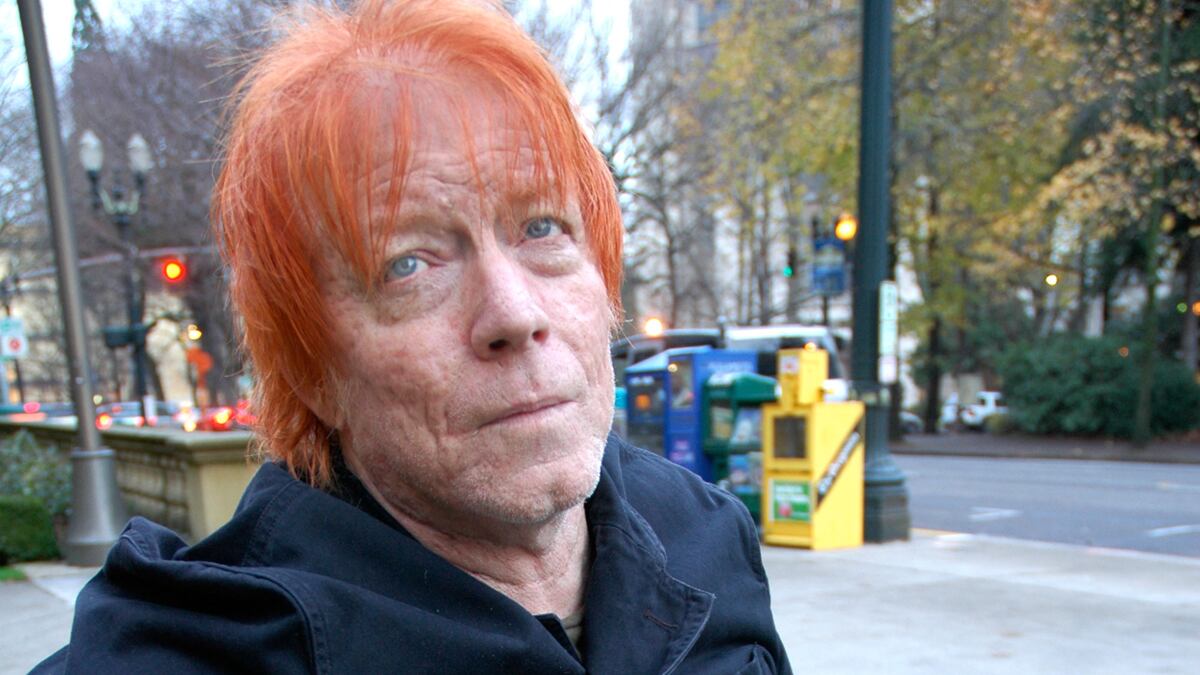In a scratchy drawing of a sheriff's posse on horseback, a wheelchair is tipped over in the desert. The sheriff turns to the others. "Don't worry," he says, "he won't get far on foot."
That caption is the name of the forthcoming Gus Van Sant movie about the life of prolific cartoonist John Callahan, a quadriplegic who spent his adult life zipping around Northwest Portland in a motorized wheelchair and published his bad-mannered drawings in Willamette Week for more than a quarter-century. It is also the epitaph on his grave.
Callahan, who died in 2010, believed in moving forward—by whatever means available.
"Self-pity or getting stuck was his enemy," says Rena Whittaker, executive director of the Good Samaritan Foundation. "What he loved to do was encourage people. To say, 'Hey, this is your life. What are you going to do with it?'"
This week, Callahan gets a new platform. A memorial garden will be unveiled Oct. 27 on the campus of the Legacy Good Samaritan Medical Center to celebrate his life, showcase his work, and maybe bring a smile to the faces of patients.
The memorial will feature 50 of Callahan's cartoons, screenprinted onto slabs of porcelain enamel, snaking through a garden of prickly plants intended to evoke the artist's sense of humor, as well as his spiky orange hair.

The memorial will occupy a narrow slice of land on Northwest Marshall Street near the Rehabilitation Institute of Oregon, or RIO, a state-of-the-art rehab center for the recently disabled.
Callahan was once a patient there. Later, he was a frequent volunteer, helping patients who may have just found out they'd never walk again.
Tad Savinar, one of three artists who designed the memorial, says Callahan's role at RIO was "to work with recently paralyzed people and kind of shock them into moving forward."

Much of Callahan's work made light of circumstances he had struggled through. He taught himself to draw again after a 1972 car wreck left him paralyzed. He was an alcoholic in recovery. His childhood in Catholic school provided a wealth of material for his work.
As a boy, Callahan started out drawing cartoons about the nuns at his grade school—a habit that often got him in trouble. He was naturally gifted in sports, but hated playing. He was the kid who was always pushing back against coaches, parents and teachers, according to his brother, Tom Callahan.
"John was pretty rebellious to authority even at a young age," Tom Callahan says. "He just had a thing about taking orders. And he always had an ability see things differently than what other people would notice."
WW published its first Callahan cartoon in 1984. Eventually, Callahan's cartoons ran in papers across the country and around the globe. His syndication grew steadily—although it contracted briefly whenever he produced a particularly offensive drawing.
Over the 27 years that WW published his cartoons, readers reacted with phone calls, angry letters and, in one case, even a boycott, recalls editor Mark Zusman.
"They gave us 24 hours to fire John," Zusman says. "We didn't."

Callahan's cartoons often ran counter to WW's point of view. But Zusman says he gave Callahan all the freedom he wanted.
"I don't remember ever sending a cartoon back and saying, 'This won't work,'" Zusman says. "The problem is, if you started worrying about what John published, you would never run anything he did."
Savinar says the team that designed the memorial wanted it to be the kind of place where Callahan might have felt comfortable.
"When you think of a nice little garden, it's not really a John Callahan kind of thing, so we twisted the word 'garden,'" says Savinar. He specializes in sensitive projects: He helped design a memorial at the scene of the Columbine High School shooting and the Holocaust Memorial in Portland's Washington Park.
Savinar teamed with graphic designer John Laursen and landscape architect Jesse Stemmler to create a "ribbon" of panels of Callahan's art curving through the garden, like a living comic strip.

"I wanted gnarled beauty," Stemmler says. "I thought of twisted, spiky plants full of unique character, like John, but it should be accessible to everybody."
Laursen says choosing from the thousands of cartoons Callahan drew was no small task.
"We wanted to showcase his skill, his humor, his willingness to test boundaries and be transgressive," Laursen says. "The biggest single challenge was representing the range of his work and the edginess of it but keeping it within what was appropriate for the hospital and people who would come across this in a public sphere with no context about who John was."
One cartoon the team debated whether to include depicts a home for patients with Alzheimer's. A person living there says, "I have half a mind to get out of here." That drew a veto.
Another showed a psychiatric ward with a sign on the door that reads, "Do not disturb any further." They kept that one.
"It's a tightrope, and everyone would walk that tightrope in a different way," Savinar says. "We were all able to agree on cartoons that portray John's sense of humor and his perspective without going out of its way to be offensive."
Whittaker says the garden will have a serious therapeutic purpose. "This will be a place where our patients who are learning to walk and talk can go and use their hands again, sometimes for the first time, and touch plants again."
Maybe it will help people laugh again, too.
GO: The John Callahan Memorial Garden will open with a dedication ceremony on Northwest Marshall Street between 21st and 22nd avenues at 11:30 am Friday, Oct. 27.


